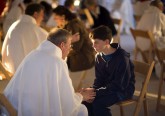Sunday Scripture: What did Jesus look like?
January 14, 2011
By Father Timothy Schehr
Second Sunday in Ordinary Time: Isaiah 49:3-6; 1 Corinthians 1:1-3; John 1:29-34
What did Jesus look like? The answer to that question seems obvious. We have all seen plenty of representations the Lord. We have seen the Lord in paintings, church windows and on the crucifix in our churches. In such conventional portrayals the Lord looks very much like we do. But we also know such portrayals of the Lord are mere conjectures by gifted artists.
So what did Jesus really look like? The Gospel for this Sunday offers the perfect opportunity for a clear description of the Lord. John the Baptist stands with some of his followers and directs their attention to Jesus coming toward him. But John says nothing about the Lord’s eyes, His brow, or the shape of His chin.
The Baptist calls Jesus “the Lamb of God.” With that title John, in fact, gives us a very accurate description of Jesus, who came into the world to offer himself back to His Father to open up for us the way to salvation. As John goes on to say, Jesus takes away the sins of the world. The title Lamb has multiple meaning when applied to Jesus. Jesus is the totally innocent lamb offered up to God. He is that ideal servant of Lord who suffers silently, as the prophet Isaiah tells us, to heal a people who have gone astray. He is the perfect Passover lamb who nourishes His people for the journey of faith.
John says a few other things about Jesus too. He says he saw the Spirit of God come down from heaven on Him “like a dove.” This description expresses the Lord’s complete innocence and His gentle character. It may also remind readers of the dove Noah sent out from the ark. It returned with a branch in its beak announcing to a weary Noah that a renewed earth awaited him and his family.
John also tells us the Spirit of God came down on Jesus and remained on Him. God’s spirit came down on others in the Bible too. This Spirit came on judges of Israel like Gideon and Samson. But we probably would not think of the Spirit as remaining on them consistently. God’s spirit likewise came down on King Saul and King David. But we later read that the Spirit departed from Saul (1 Samuel 16:14), and King David certainly did not act as if he had God’s spirit all the time. But we can confidently say the Sprit remained on Jesus.
Finally the baptism tells us that Jesus will baptize with the Holy Spirit and that Jesus is the Son of God. This news brings to a rousing conclusion John’s testimony about Jesus. Now we have a complete picture of Jesus, a picture giving us much more meaningful information than any physical description could no matter how detailed.
In the first reading we hear, in an oracle from Isaiah, the suffering servant’s own reflections on his mission from God. He knows God formed him from the womb to carry forward the great task of leading the children of Abraham back to God. In fact, he tells us, this was not enough. God expands his mission to embrace all the nations of the world. This is precisely what Jesus accomplished for His heavenly Father. He fulfilled perfectly the mission of the suffering servant about whom Isaiah never tires of speaking.
In the second reading, Paul is confident that he too is fulfilling a mission given to him by God. Paul opens his letter to the church in Corinth by declaring that he was called to be an apostle. But Paul turns the attention away from himself and to his readers who have been sanctified “in Christ Jesus” and who have themselves been called to be holy. He wishes upon them grace and peace from the Father and the Son. Once again we have a portrait of the inner person that far exceeds any detailed photograph. Father Schehr is a faculty member at the Athenaeum of Ohio.










